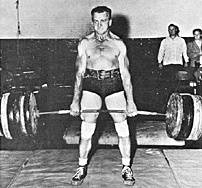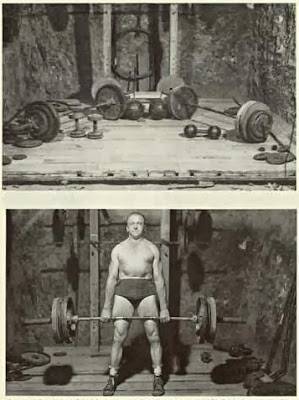Bob Peoples deadlifted 725lbs at 181lbs bodyweight and at the age of forty. This was back in the 1949, on his farm, with limited training equipment, and before the deadlift became popular. Although people have pulled more than him today, he is certainly one of the greatest of all time.
The interesting thing about Peoples is that his deadlift ran contrary to everything that is taught today. Not only did he round his back, but he blew the air out of his lungs before lifting. Why would he do such a thing? Bob studied the form of his lift by viewing himself in a mirror. It was this process over time that led him towards his unique and controversial style of lifting.
I than started lifting on empty lungs and with at round back – that is I would breath out to normal then do my dead lift. I feel this is much safer than following the customary advice of the experts to take a deep breath and than dead lift. Breathing out you lessen the internal pressure and by lifting with a round back you lessen the leverage – all of which helps add many lbs. to your lift. I realize this style may not work well with everyone but in my case it seems ideal.
Peary Radar, bodybuilder, writer, and publisher, said, “His dead lift style is a little different than we usually feel is ‘correct’ in that he performs his lifts almost straight legged. This style however, is not ‘incorrect’ for him because his type of physique with rather long legs, short trunk and very long arms makes it the best style for him.” I’ve been round-back deadlifting and doing it successfully for some time, and after studying up on the method Peoples employed I plan on experimenting with his style. Looking at pictures, I don’t quite have the arm length he did, but perhaps I can find a better position that may be closer to what he used.
Although the deadlift was the favorite lift of Peoples, and what made him famous, he was no slouch in the other lifts. He performed a 225lb press and 530lb squat as well as many other impressive lifts. But for this article we’re going to focus on what he was best at, and the inventive and rarely seen today methods he employed to gain a quadruple-times bodyweight lift.
In a previous article on Hermann Goerner, we discussed the many variations of the deadlift Goerner used in training. These were mostly grip-oriented variations. Bob Peoples was much more focused on just the deadlift, but working it from various partial and extended heights, as well as doing it in rare forms like the negative. If you combined the two you’d have nearly endless deadlift variations to work on.
The Deadlifting Exercises Used by Bob Peoples
Dead Hang Deadlifts – Peoples started at the top out of a rack, lowered down to just above the ground, then came back up. Using the negative first, you can lift more than starting from the ground as is normally done.
Extended Range of Motion Trapbar Deadlift – This required Peoples to go into a full squat and bent-over position. This exercise was specifically used to build more starting strength.
 Deadlifts From a Partial Range of Motion Just Below, At, or Above Kneecaps – Anyone with experience using partials knows they can strengthen different parts of the lift making you strong throughout. You can handle bigger weights than a full-range lift and the benefit carries over. In fact, Peoples created his own form of a power rack for these purposes before there were power racks.
Deadlifts From a Partial Range of Motion Just Below, At, or Above Kneecaps – Anyone with experience using partials knows they can strengthen different parts of the lift making you strong throughout. You can handle bigger weights than a full-range lift and the benefit carries over. In fact, Peoples created his own form of a power rack for these purposes before there were power racks.
Stiff Leg Deadlifts – These were sometimes done in normal style and sometimes with dead hangs. It was probably the mixing of these with regular deadlifts that help build the strength Peoples had in the near straight leg deadlift position.
Holding Heavy Weights in the Hands at the Finish Position – Peoples focused on the fact that grip strength was often the weak point in training some of these exercises. He used hooks and straps for that reason, but also focused on exercises like this one to strengthen his grip.
Various Deadlift Isometrics – In addition to all the moving exercises, Peoples employed different isometrics so he could pull as hard as possible against immovable objects at different heights along the deadlift path.
Rapid or “Hopper” Deadlifts – These were done by bouncing the bar off of the floor or pins. The added momentum used in combination with the negative allowed Peoples to handle more weight than without it, and thus it was helpful in breaking into using heavier loads.
The Training Program Used by Bob Peoples
 As with anyone’s workouts, the training program used by Peoples evolved over time. But there were some principles he stuck to for the most part over his lifting career. Peoples explained, “You will note that I did not use any set schedule but varied the program between the lifts according to the way I felt, some days doing just one lift and on others doing several. Most of the time I worked every day but never did more than 3 to 5 reps in any lift.”
As with anyone’s workouts, the training program used by Peoples evolved over time. But there were some principles he stuck to for the most part over his lifting career. Peoples explained, “You will note that I did not use any set schedule but varied the program between the lifts according to the way I felt, some days doing just one lift and on others doing several. Most of the time I worked every day but never did more than 3 to 5 reps in any lift.”
In training for a world record in the deadlift back in 1946, Peoples trained daily in this manner. He worked on the three Olympic lifts (the press being included with the jerk and snatch back then), followed by the deadlift. He started at 350lbs, adding 50lbs in each set and doing three reps until reaching the max he could handle. And remember, this was daily training. Peoples also worked the squat into his training:
Another method of training that gave me good results was to alternate between dead lifts and the squats. I’d work on the dead lift alone for a time. I’d start out with single attempts and work up to my limit. I would work at this every day until I began to go stale, then I quit the dead lift and went to work on the squat with the same system, and so on back and forth. This system gave me very good results.
I find this interesting because I felt my deadlift progress was going somewhat stale and thought that to further improve it I would best focus on the squat, which I have not done nearly as much. Although I don’t care so much about what I can squat (hence, my not doing it), I do want to drive my deadlift up higher, so it’s great to see this confirmation about how the squat can help. Try incorporating some of these exercises or training styles into your own workouts and you may find your own deadlift gets higher and higher.
References:
1. Iron Man, April/May 1952 – http://www.myosynthesis.com/






